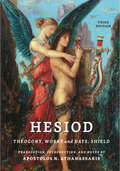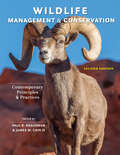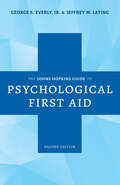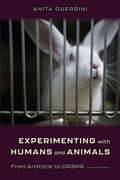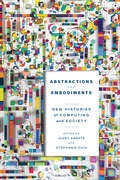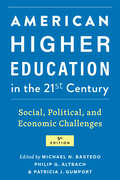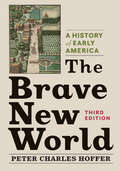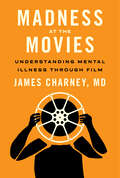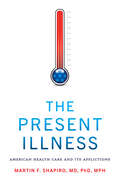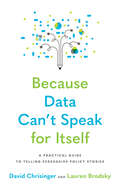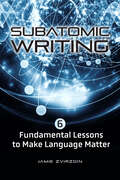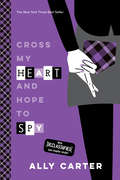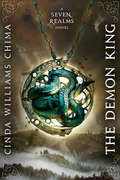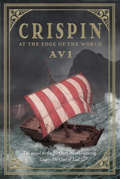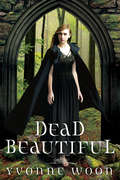- Table View
- List View
Hesiod: Theogony, Works and Days, Shield
by Apostolos N. AthanassakisThis best-selling translation of Hesiod's the Theogony, the Works and Days, and the Shield has been updated into the most indispensable edition yet for students of Greek mythology and literature.Next to the works of Homer, Hesiod's poems are foundational texts for students of the classics. His two major surviving works, the Theogony and the Works and Days, address the divine and the mundane, respectively. The Theogony traces the origins of the Greek gods and recounts the events surrounding the crowning of Zeus as their king, while the Works and Days is a manual of moral instruction in verse addressed to farmers and peasants. Though modern scholars dispute the authorship of the Shield, ancient texts treat this final poem about the shield of Herakles as unquestionably Hesiodic.Introducing his celebrated translations of Hesiod, Apostolos N. Athanassakis positions the philosopher-poet as heir to a long tradition of Hellenic poetry. Hesiod's poems demonstrate the author's passionate interest in the governance of human society through justice and a tangible work ethic. As a physicist and a materialist, Hesiod avoided such subjects as honor and the afterlife. His works contain the oldest fundamentals on law and Greek economy, making Hesiod the first great thinker of Western civilization. Athanassakis's contextual notes offer both comparison to Biblical and Norse mythologies as well as anthropological connections to modern Greece.The third edition of this classic undergraduate text includes a thoroughly updated bibliography reflecting the last two decades of scholarship. The introductions and notes have been enriched, clarifying contextual history and the meaning of Hesiod's own language and themes, and notes have been newly added to the Shield. Athanassakis has lightly improved his translation throughout the text, expertly balancing the natural flow of the verse while adhering closely to the literal Greek.
Hesiod: Theogony, Works and Days, Shield
by Apostolos N. AthanassakisThis best-selling translation of Hesiod's the Theogony, the Works and Days, and the Shield has been updated into the most indispensable edition yet for students of Greek mythology and literature.Next to the works of Homer, Hesiod's poems are foundational texts for students of the classics. His two major surviving works, the Theogony and the Works and Days, address the divine and the mundane, respectively. The Theogony traces the origins of the Greek gods and recounts the events surrounding the crowning of Zeus as their king, while the Works and Days is a manual of moral instruction in verse addressed to farmers and peasants. Though modern scholars dispute the authorship of the Shield, ancient texts treat this final poem about the shield of Herakles as unquestionably Hesiodic.Introducing his celebrated translations of Hesiod, Apostolos N. Athanassakis positions the philosopher-poet as heir to a long tradition of Hellenic poetry. Hesiod's poems demonstrate the author's passionate interest in the governance of human society through justice and a tangible work ethic. As a physicist and a materialist, Hesiod avoided such subjects as honor and the afterlife. His works contain the oldest fundamentals on law and Greek economy, making Hesiod the first great thinker of Western civilization. Athanassakis's contextual notes offer both comparison to Biblical and Norse mythologies as well as anthropological connections to modern Greece.The third edition of this classic undergraduate text includes a thoroughly updated bibliography reflecting the last two decades of scholarship. The introductions and notes have been enriched, clarifying contextual history and the meaning of Hesiod's own language and themes, and notes have been newly added to the Shield. Athanassakis has lightly improved his translation throughout the text, expertly balancing the natural flow of the verse while adhering closely to the literal Greek.
Wildlife Management and Conservation: Contemporary Principles and Practices
by Paul R. Krausman James W. CainThe definitive textbook for students of wildlife management, now updated to cover the latest techniques, tools, and topics.Wildlife Management and Conservation presents a clear overview of the management and conservation of animals, their habitats, and how people influence both. The relationship among these three components of wildlife management is explained in chapters written by leading experts and is designed to prepare students for careers in which they will be charged with maintaining healthy animal populations. To be successful wildlife professionals, they will need to find ways to restore depleted populations, reduce overabundant, introduced, or pest species, and manage relationships among various human stakeholders. This book gives them the basic knowledge necessary to accomplish these goals.This second edition, which is updated throughout, features several new and expanded topics, including communication in the wildlife profession, fire science, Indigenous models of management and conservation, plant–animal interactions, quantitative analysis of wildlife populations, and a detailed glossary. The book also covers:• Human dimensions of wildlife management• Animal behavior• Predator–prey relationships• Structured decision making• Issues of scale in wildlife management• Wildlife health• Historical context of wildlife management and conservation• Hunting and trapping• Nongame species• Nutrition ecology• Water management• Climate change• Conservation planningThe most widely used foundational text in the field, this is the perfect resource not only for students but also for early career professionals and those in related fields who need to understand the core tenets and tools of wildlife conservation and management.Contributors: C. Jane Anderson, Bart M. Ballard, Warren B. Ballard, John A. Bissonette, Clint Boal, Scott B. Boyle, Leonard A. Brennan, Robert D. Brown, James W. Cain III, Tyler A. Campbell, Michael J. Cherry, Michael R. Conover, Daniel J. Decker, Randall W. DeYoung, Jonathan B. Dinkins, W. Sue Fairbanks, Selma N. Glasscock, James B. Grand, Michael J. Haney, James R. Heffelfinger, Scott E. Henke, Fidel Hernandez, Davie G. Hewitt, C. L. Hoving, David A. Jessup, Heather E. Johnson, Winifred B. Kessler, John L. Koprowski, Paul R. Krausman, William P. Kuvlesky, Jr., Roel R. Lopez, R. W. Mannan, Scott Mills, Michael S. Mitchell, Michael L. Morrison, Anna M. Muñoz, John F. Organ, Katherine L. Parker, William F. Porter, Shawn J. Riley, Steven S. Rosenstock, Michael C. Runge, Susan P. Rupp, William F. Siemer, Robert J. Steidl, Kelley M. Stewart
Wildlife Management and Conservation: Contemporary Principles and Practices
by Paul R. Krausman And James W. Cain IIIThe definitive textbook for students of wildlife management, now updated to cover the latest techniques, tools, and topics.Wildlife Management and Conservation presents a clear overview of the management and conservation of animals, their habitats, and how people influence both. The relationship among these three components of wildlife management is explained in chapters written by leading experts and is designed to prepare students for careers in which they will be charged with maintaining healthy animal populations. To be successful wildlife professionals, they will need to find ways to restore depleted populations, reduce overabundant, introduced, or pest species, and manage relationships among various human stakeholders. This book gives them the basic knowledge necessary to accomplish these goals.This second edition, which is updated throughout, features several new and expanded topics, including communication in the wildlife profession, fire science, Indigenous models of management and conservation, plant–animal interactions, quantitative analysis of wildlife populations, and a detailed glossary. The book also covers:• Human dimensions of wildlife management• Animal behavior• Predator–prey relationships• Structured decision making• Issues of scale in wildlife management• Wildlife health• Historical context of wildlife management and conservation• Hunting and trapping• Nongame species• Nutrition ecology• Water management• Climate change• Conservation planningThe most widely used foundational text in the field, this is the perfect resource not only for students but also for early career professionals and those in related fields who need to understand the core tenets and tools of wildlife conservation and management.Contributors: C. Jane Anderson, Bart M. Ballard, Warren B. Ballard, John A. Bissonette, Clint Boal, Scott B. Boyle, Leonard A. Brennan, Robert D. Brown, James W. Cain III, Tyler A. Campbell, Michael J. Cherry, Michael R. Conover, Daniel J. Decker, Randall W. DeYoung, Jonathan B. Dinkins, W. Sue Fairbanks, Selma N. Glasscock, James B. Grand, Michael J. Haney, James R. Heffelfinger, Scott E. Henke, Fidel Hernandez, Davie G. Hewitt, C. L. Hoving, David A. Jessup, Heather E. Johnson, Winifred B. Kessler, John L. Koprowski, Paul R. Krausman, William P. Kuvlesky, Jr., Roel R. Lopez, R. W. Mannan, Scott Mills, Michael S. Mitchell, Michael L. Morrison, Anna M. Muñoz, John F. Organ, Katherine L. Parker, William F. Porter, Shawn J. Riley, Steven S. Rosenstock, Michael C. Runge, Susan P. Rupp, William F. Siemer, Robert J. Steidl, Kelley M. Stewart
The Johns Hopkins Guide to Psychological First Aid
by George S. Everly Jr. Jeffrey M. LatingLearn the essential skills of psychological first aid from the experts—the creators of the Johns Hopkins RAPID PFA method.Psychological first aid, or PFA, is designed to mitigate the effects of acute stress and trauma and assist those in crisis to cope effectively. PFA can be applied in emergencies, including disasters, terrorist attacks, and the COVID-19 pandemic. In the second edition of this essential guide, George S. Everly, Jr., and Jeffrey M. Lating draw on their experiences in Kuwait after the Gulf War, in New York City after the September 11 attacks, and during the COVID-19 pandemic to describe the principles and practices of PFA in an easy-to-follow, prescriptive, and practical manner. Informed by current events, the second edition includes updated chapters as well as three completely new chapters on • cultural awareness• PFA considerations with children• the use of PFA to facilitate community mental health and resilienceAimed at mental health practitioners, first responders, and global health disaster teams such as Médecins Sans Frontières and the World Health Organization, but also beneficial to those with little or no previous mental health training, The Johns Hopkins Guide to Psychological First Aid thoroughly explains RAPID PFA. RAPID, a unique evidence-informed and evidence-based PFA method, follows a set of easily understood principles. In each chapter, Everly and Lating—who have traveled nationally and internationally to teach the RAPID PFA model in numerous public health, fire, police, military, business, and faith-based settings—provide a step-by-step approach and include a key point summary. A unifying case exemplifies each phase of the RAPID PFA model in an ongoing dialogue that presents ideal PFA responses, examples of common mistakes, and various outcomes.
The Johns Hopkins Guide to Psychological First Aid
by George S. Everly Jr. Jeffrey M. LatingLearn the essential skills of psychological first aid from the experts—the creators of the Johns Hopkins RAPID PFA method.Psychological first aid, or PFA, is designed to mitigate the effects of acute stress and trauma and assist those in crisis to cope effectively. PFA can be applied in emergencies, including disasters, terrorist attacks, and the COVID-19 pandemic. In the second edition of this essential guide, George S. Everly, Jr., and Jeffrey M. Lating draw on their experiences in Kuwait after the Gulf War, in New York City after the September 11 attacks, and during the COVID-19 pandemic to describe the principles and practices of PFA in an easy-to-follow, prescriptive, and practical manner. Informed by current events, the second edition includes updated chapters as well as three completely new chapters on • cultural awareness• PFA considerations with children• the use of PFA to facilitate community mental health and resilienceAimed at mental health practitioners, first responders, and global health disaster teams such as Médecins Sans Frontières and the World Health Organization, but also beneficial to those with little or no previous mental health training, The Johns Hopkins Guide to Psychological First Aid thoroughly explains RAPID PFA. RAPID, a unique evidence-informed and evidence-based PFA method, follows a set of easily understood principles. In each chapter, Everly and Lating—who have traveled nationally and internationally to teach the RAPID PFA model in numerous public health, fire, police, military, business, and faith-based settings—provide a step-by-step approach and include a key point summary. A unifying case exemplifies each phase of the RAPID PFA model in an ongoing dialogue that presents ideal PFA responses, examples of common mistakes, and various outcomes.
Experimenting with Humans and Animals: From Aristotle to CRISPR (Johns Hopkins Introductory Studies in the History of Science)
by Anita GuerriniExamining the ideas and attitudes that encourage scientists to experiment on living creatures, what their justifications are, and how these have changed over time.Experimentation on animals—particularly humans—is often assumed to be a uniquely modern phenomenon. But the ideas and attitudes that encourage biological and medical scientists to experiment on living creatures date from the earliest expressions of Western thought. In Experimenting with Humans and Animals, Anita Guerrini looks at the history of these practices and examines the philosophical and ethical arguments that justified them.Guerrini discusses key historical episodes in the use of living beings in science and medicine, including the discovery of blood circulation, the development of smallpox and polio vaccines, and recent research in genetics, ecology, and animal behavior. She also explores the rise of the antivivisection movement in Victorian England, the modern animal rights movement, and current debates over gene therapy and genetically engineered animals. We learn how perceptions and understandings of human and animal pain have changed; how ideas of class, race, and gender have defined the human research subject; and that the ethical values of science seldom stray far from the society in which scientists live and work.Thoroughly rewritten and updated, with new material in every chapter, the book emphasizes a broader understanding of experimentation and adds material on gene therapy, self-experimentation, and prisoners and slaves as experimental subjects. A new chapter brings the story up to the present while reflecting on the current regulatory scene, new developments in science, and emerging genomics. Experimenting with Humans and Animals offers readers a context within which to understand more fully the responsibility we all bear for the suffering inflicted on other living beings in the name of scientific knowledge.
Experimenting with Humans and Animals: From Aristotle to CRISPR (Johns Hopkins Introductory Studies in the History of Science)
by Anita GuerriniExamining the ideas and attitudes that encourage scientists to experiment on living creatures, what their justifications are, and how these have changed over time.Experimentation on animals—particularly humans—is often assumed to be a uniquely modern phenomenon. But the ideas and attitudes that encourage biological and medical scientists to experiment on living creatures date from the earliest expressions of Western thought. In Experimenting with Humans and Animals, Anita Guerrini looks at the history of these practices and examines the philosophical and ethical arguments that justified them.Guerrini discusses key historical episodes in the use of living beings in science and medicine, including the discovery of blood circulation, the development of smallpox and polio vaccines, and recent research in genetics, ecology, and animal behavior. She also explores the rise of the antivivisection movement in Victorian England, the modern animal rights movement, and current debates over gene therapy and genetically engineered animals. We learn how perceptions and understandings of human and animal pain have changed; how ideas of class, race, and gender have defined the human research subject; and that the ethical values of science seldom stray far from the society in which scientists live and work.Thoroughly rewritten and updated, with new material in every chapter, the book emphasizes a broader understanding of experimentation and adds material on gene therapy, self-experimentation, and prisoners and slaves as experimental subjects. A new chapter brings the story up to the present while reflecting on the current regulatory scene, new developments in science, and emerging genomics. Experimenting with Humans and Animals offers readers a context within which to understand more fully the responsibility we all bear for the suffering inflicted on other living beings in the name of scientific knowledge.
Abstractions and Embodiments: New Histories of Computing and Society (Studies in Computing and Culture)
by Janet Abbate and Stephanie DickCutting-edge historians explore ideas, communities, and technologies around modern computing to explore how computers mediate social relations.Computers have been framed both as a mirror for the human mind and as an irreducible other that humanness is defined against, depending on different historical definitions of "humanness." They can serve both liberation and control because some people's freedom has historically been predicated on controlling others. Historians of computing return again and again to these contradictions, as they often reveal deeper structures.Using twin frameworks of abstraction and embodiment, a reformulation of the old mind-body dichotomy, this anthology examines how social relations are enacted in and through computing. The authors examining "Abstraction" revisit central concepts in computing, including "algorithm," "program," "clone," and "risk." In doing so, they demonstrate how the meanings of these terms reflect power relations and social identities. The section on "Embodiments" focuses on sensory aspects of using computers as well as the ways in which gender, race, and other identities have shaped the opportunities and embodied experiences of computer workers and users. Offering a rich and diverse set of studies in new areas, the book explores such disparate themes as disability, the influence of the punk movement, working mothers as technical innovators, and gaming behind the Iron Curtain. Abstractions and Embodiments reimagines computing history by questioning canonical interpretations, foregrounding new actors and contexts, and highlighting neglected aspects of computing as an embodied experience. It makes the profound case that both technology and the body are culturally shaped and that there can be no clear distinction between social, intellectual, and technical aspects of computing. Contributors: Janet Abbate, Marc Aidinoff, Troy Kaighin Astarte, Ekaterina Babinsteva, André Brock, Maarten Bullynck, Jiahui Chan, Gerardo Con Diaz, Liesbeth De Mol, Stephanie Dick, Kelcey Gibbons, Elyse Graham, Michael J. Halvorson, Mar Hicks, Scott Kushner, Xiaochang Li, Zachary Loeb, Lisa Nakamura, Tiffany Nichols, Laine Nooney, Elizabeth Petrick, Cierra Robson, Hallam Stevens, Jaroslav Švelch
Abstractions and Embodiments: New Histories of Computing and Society (Studies in Computing and Culture)
by Janet Abbate Stephanie DickCutting-edge historians explore ideas, communities, and technologies around modern computing to explore how computers mediate social relations.Computers have been framed both as a mirror for the human mind and as an irreducible other that humanness is defined against, depending on different historical definitions of "humanness." They can serve both liberation and control because some people's freedom has historically been predicated on controlling others. Historians of computing return again and again to these contradictions, as they often reveal deeper structures.Using twin frameworks of abstraction and embodiment, a reformulation of the old mind-body dichotomy, this anthology examines how social relations are enacted in and through computing. The authors examining "Abstraction" revisit central concepts in computing, including "algorithm," "program," "clone," and "risk." In doing so, they demonstrate how the meanings of these terms reflect power relations and social identities. The section on "Embodiments" focuses on sensory aspects of using computers as well as the ways in which gender, race, and other identities have shaped the opportunities and embodied experiences of computer workers and users. Offering a rich and diverse set of studies in new areas, the book explores such disparate themes as disability, the influence of the punk movement, working mothers as technical innovators, and gaming behind the Iron Curtain. Abstractions and Embodiments reimagines computing history by questioning canonical interpretations, foregrounding new actors and contexts, and highlighting neglected aspects of computing as an embodied experience. It makes the profound case that both technology and the body are culturally shaped and that there can be no clear distinction between social, intellectual, and technical aspects of computing. Contributors: Janet Abbate, Marc Aidinoff, Troy Kaighin Astarte, Ekaterina Babinsteva, André Brock, Maarten Bullynck, Jiahui Chan, Gerardo Con Diaz, Liesbeth De Mol, Stephanie Dick, Kelcey Gibbons, Elyse Graham, Michael J. Halvorson, Mar Hicks, Scott Kushner, Xiaochang Li, Zachary Loeb, Lisa Nakamura, Tiffany Nichols, Laine Nooney, Elizabeth Petrick, Cierra Robson, Hallam Stevens, Jaroslav Švelch
American Higher Education in the Twenty-First Century: Social, Political, and Economic Challenges
by Michael N. Bastedo, Philip G. Altbach, and Patricia J. GumportNow in its fifth edition! An indispensable reference for anyone concerned with the future of American colleges and universities.Whether it is advances in information technology, organized social movements, or racial inequality and social class stratification, higher education serves as a lens for examining significant issues within American society. First published in 1998, American Higher Education in the Twenty-First Century offers a comprehensive introduction to the complex realities of American higher education, including its history, financing, governance, and relationship with the states and federal government. This thoroughly revised edition brings the classic volume completely up to date. Each chapter has been rewritten to address major recent issues in higher education, including the COVID-19 pandemic, the movement for racial justice, and turmoil in the for-profit sector. Three entirely new chapters cover broad-access colleges, race and racism, and organized social movements. Reflecting on the implications of ethnic and socioeconomic diversity within higher education, the book also grapples with growing concerns about the responsiveness and future of the academy.No other book covers such wide-ranging issues under the broader theme of higher education's relationship to society. Highly acclaimed and incorporating cutting-edge research, American Higher Education in the Twenty-First Century is now more useful and engaging than ever.Contributors: Michael N. Bastedo, Philip G. Altbach, Patricia J. Gumport, Peter Riley Bahr, Joy Blanchard, Julia Brickfield, Michael Brown, Katherine S. Cho, Daniela Conde, Charles H. F. Davis III, Hans de Wit, Peter D. Eckel, Martin Finkelstein, Denisa Gándara, Liliana M. Garces, Roger L. Geiger, Leslie D. Gonzales, Jillian Leigh Gross, Jessica Harris, Nicholas Hillman, Julia Rose Karpicz, Robert Kelchen, Adrianna Kezar, Lisa R. Lattuca, Demetri Morgan, Rebecca Natow, Anna Neumann, Audrey Peek, Laura W. Perna, Gary Rhoades, Tykeia N. Robinson, Roman Ruiz, Wonson Ryu, Lauren T. Schudde, Jeffrey C. Sun, David A. Tandberg
American Higher Education in the Twenty-First Century: Social, Political, and Economic Challenges
by Michael N. Bastedo Philip G. Altbach Patricia J. GumportNow in its fifth edition! An indispensable reference for anyone concerned with the future of American colleges and universities.Whether it is advances in information technology, organized social movements, or racial inequality and social class stratification, higher education serves as a lens for examining significant issues within American society. First published in 1998, American Higher Education in the Twenty-First Century offers a comprehensive introduction to the complex realities of American higher education, including its history, financing, governance, and relationship with the states and federal government. This thoroughly revised edition brings the classic volume completely up to date. Each chapter has been rewritten to address major recent issues in higher education, including the COVID-19 pandemic, the movement for racial justice, and turmoil in the for-profit sector. Three entirely new chapters cover broad-access colleges, race and racism, and organized social movements. Reflecting on the implications of ethnic and socioeconomic diversity within higher education, the book also grapples with growing concerns about the responsiveness and future of the academy.No other book covers such wide-ranging issues under the broader theme of higher education's relationship to society. Highly acclaimed and incorporating cutting-edge research, American Higher Education in the Twenty-First Century is now more useful and engaging than ever.Contributors: Michael N. Bastedo, Philip G. Altbach, Patricia J. Gumport, Peter Riley Bahr, Joy Blanchard, Julia Brickfield, Michael Brown, Katherine S. Cho, Daniela Conde, Charles H. F. Davis III, Hans de Wit, Peter D. Eckel, Martin Finkelstein, Denisa Gándara, Liliana M. Garces, Roger L. Geiger, Leslie D. Gonzales, Jillian Leigh Gross, Jessica Harris, Nicholas Hillman, Julia Rose Karpicz, Robert Kelchen, Adrianna Kezar, Lisa R. Lattuca, Demetri Morgan, Rebecca Natow, Anna Neumann, Audrey Peek, Laura W. Perna, Gary Rhoades, Tykeia N. Robinson, Roman Ruiz, Wonson Ryu, Lauren T. Schudde, Jeffrey C. Sun, David A. Tandberg
The Brave New World: A History of Early America
by Peter Charles HofferA lively synthesis of early American history, now in its third edition.The Brave New World covers the entire span of early American history, from 30,000 years before Europeans landed on North American shores to the Revolutionary War. With its exploration of the places and peoples of early America, this comprehensive new edition of a classic textbook brings together the most recent scholarship on the colonial and revolutionary eras, Native Americans, slavery and the slave trade, politics, war, and the daily lives of ordinary people.In this edition, Peter Charles Hoffer incorporates the wealth of innovative work on early American history, including fresh material on• environmental history• the Dutch and French Caribbean• Indigenous societies• consumer goods• mapping• captivity tales• settler imperialism• power—who has it, who wants it, how it is expressed, and how it is opposedEmphasizing how diverse and entangled the early American imperial world was, this edition also greatly expands the geographical scope of the book. An updated bibliographic essay offering short descriptions of relevant books, articles, collections, and anthologies rounds out the volume. Wide-ranging and inclusive, The Brave New World continues to provide students, instructors, and historians with an engaging and accessible history of early North America.
Madness at the Movies: Understanding Mental Illness through Film
by James CharneyA unique exploration of how mental illness is portrayed in classic and contemporary films.The study of classic and contemporary films can provide a powerful avenue to understand the experience of mental illness. In Madness at the Movies, James Charney, MD, a practicing psychiatrist and long-time cinephile, examines films that delve deeply into characters' inner worlds, and he analyzes moments that help define their particular mental illness. Based on the highly popular course that Charney taught at Yale University and the American University of Rome, Madness at the Movies introduces readers to films that may be new to them and encourages them to view these films in an entirely new way. Through films such as Psycho, Taxi Driver, Through a Glass Darkly, Night of the Hunter, A Woman Under the Influence, Ordinary People, and As Good As It Gets, Charney covers an array of disorders, including psychosis, paranoia, psychopathy, depression, bipolar disorder, obsessive-compulsive disorder, and anxiety. He examines how these films work to convey the essence of each illness. He also looks at how each film reflects the understanding of mental illness at the time it was released as well as the culture that shaped that understanding.Charney explains how to observe the behaviors displayed by characters in the films, paying close attention to signs of mental illness. He demonstrates that learning to read a film can be as absorbing as watching one. By viewing these films through the lens of mental health, readers can hone their observational skills and learn to assess the accuracy of depictions of mental illness in popular media.
The Present Illness: American Health Care and Its Afflictions
by Martin F. ShapiroBeyond political posturing and industry quick-fixes, why is the American health care system so difficult to reform?Health care reform efforts are difficult to achieve and have been historically undermined by their narrow scope. In The Present Illness, Martin F. Shapiro, MD, PhD, MPH, weaves together history, sociology, extensive research, and his own experiences as a physician to explore the broad range of afflictions impairing US health care and explains why we won't be able to fix the system without making significant changes across society. With a sharp eye and ready humor, Shapiro dissects the ways all groups participating—clinicians and their organizations, medical schools and their faculty, hospitals and clinical corporations, scientists and the National Institutes of Health, insurers and manufacturers, governments and their policies, and also patients and the public—shape and reinforce a dysfunctional system. Shapiro identifies three major problems stymieing reform: commodification of care; values, expectations, unmet needs, attitudes, and personal limitations of participants; and toxic relationships and communication among these groups.Shapiro lays out a sweeping agenda of concrete actions to address the many factors contributing to the system's failings. Highlighting the interconnectedness of both the problems and potential solutions, he warns that piecemeal reform efforts will continue to be undermined by those who believe they have something to gain from the status quo. Although overhauling our health care system is daunting, Shapiro nonetheless concludes that we must push forward with a far more comprehensive effort in all sectors of health care and throughout society to create a system that is humane, effective, and just.
The Present Illness: American Health Care and Its Afflictions
by Martin F. ShapiroBeyond political posturing and industry quick-fixes, why is the American health care system so difficult to reform?Health care reform efforts are difficult to achieve and have been historically undermined by their narrow scope. In The Present Illness, Martin F. Shapiro, MD, PhD, MPH, weaves together history, sociology, extensive research, and his own experiences as a physician to explore the broad range of afflictions impairing US health care and explains why we won't be able to fix the system without making significant changes across society. With a sharp eye and ready humor, Shapiro dissects the ways all groups participating—clinicians and their organizations, medical schools and their faculty, hospitals and clinical corporations, scientists and the National Institutes of Health, insurers and manufacturers, governments and their policies, and also patients and the public—shape and reinforce a dysfunctional system. Shapiro identifies three major problems stymieing reform: commodification of care; values, expectations, unmet needs, attitudes, and personal limitations of participants; and toxic relationships and communication among these groups.Shapiro lays out a sweeping agenda of concrete actions to address the many factors contributing to the system's failings. Highlighting the interconnectedness of both the problems and potential solutions, he warns that piecemeal reform efforts will continue to be undermined by those who believe they have something to gain from the status quo. Although overhauling our health care system is daunting, Shapiro nonetheless concludes that we must push forward with a far more comprehensive effort in all sectors of health care and throughout society to create a system that is humane, effective, and just.
Because Data Can't Speak for Itself: A Practical Guide to Telling Persuasive Policy Stories
by David Chrisinger Lauren BrodskyA guide for how to tell clear, data-driven stories that will make an impact.People with important evidence-based ideas often struggle to translate data into stories their readers can relate to and understand. And if leaders can't communicate well to their audience, they will not be able to make important changes in the world. Why do some evidence-based ideas thrive while others die? And how do we improve the chances of worthy ideas? In Because Data Can't Speak for Itself, accomplished educators and writers David Chrisinger and Lauren Brodsky tackle these questions head-on. They reveal the parts and functions of effective data-driven stories and explain myriad ways to turn your data dump into a narrative that can inform, persuade, and inspire action. Chrisinger and Brodsky show that convincing data-driven stories draw their power from the same three traits, which they call people, purpose, and persistence. Writers need to find the real people behind the numbers and share their stories. At the same time, they need to remember their own purpose and be honest about what data says—and, just as importantly, what it does not. Compelling and concise, this fast-paced tour of success stories—and several failures—includes examples on topics such as COVID-19, public diplomacy, and criminal justice. Chrisinger and Brodsky's easy-to-apply tool kit will turn anyone into an effective and persuasive evidence-based writer. Aimed at policy analysts, politicians, journalists, teachers, and business leaders, Because Data Can't Speak for Itself will transform the way you communicate ideas.
Because Data Can't Speak for Itself: A Practical Guide to Telling Persuasive Policy Stories
by David Chrisinger Lauren BrodskyA guide for how to tell clear, data-driven stories that will make an impact.People with important evidence-based ideas often struggle to translate data into stories their readers can relate to and understand. And if leaders can't communicate well to their audience, they will not be able to make important changes in the world. Why do some evidence-based ideas thrive while others die? And how do we improve the chances of worthy ideas? In Because Data Can't Speak for Itself, accomplished educators and writers David Chrisinger and Lauren Brodsky tackle these questions head-on. They reveal the parts and functions of effective data-driven stories and explain myriad ways to turn your data dump into a narrative that can inform, persuade, and inspire action. Chrisinger and Brodsky show that convincing data-driven stories draw their power from the same three traits, which they call people, purpose, and persistence. Writers need to find the real people behind the numbers and share their stories. At the same time, they need to remember their own purpose and be honest about what data says—and, just as importantly, what it does not. Compelling and concise, this fast-paced tour of success stories—and several failures—includes examples on topics such as COVID-19, public diplomacy, and criminal justice. Chrisinger and Brodsky's easy-to-apply tool kit will turn anyone into an effective and persuasive evidence-based writer. Aimed at policy analysts, politicians, journalists, teachers, and business leaders, Because Data Can't Speak for Itself will transform the way you communicate ideas.
Subatomic Writing: Six Fundamental Lessons to Make Language Matter
by Jamie ZvirzdinSee science writing fundamentals afresh through a subatomic lens!In Subatomic Writing, Johns Hopkins University instructor Jamie Zvirzdin goes bravely into uncharted territory by offering a totally new kind of guide for writing about science—from the subatomic level up! Subatomic Writing teaches readers that the building blocks of language are like particles in physics. These particles, combined and arranged, form something greater than their parts: all matter in the literary universe. The six levels of language covered in this guide create writing that illuminates and energizes the reader to feel, learn, change, and act. This interdisciplinary approach helps scientists, science writers, and editors improve their writing in fundamental areas as they build from the sounds in a word to the pacing of a paragraph. These areas include• Sound and sense• Word classes• Grammar and syntax• Punctuation• Rhythm and emphasis• Pacing and coherenceEqually helpful for students who need to learn how to write clearly about science and scientists who need to hone their writing skills to create more effective course material, papers, and grant applications, this guide builds confidence in writing abilities as old skills are taught in new, exciting ways. Each lesson provides exercises that build on each other, strengthening readers' capacity to communicate ideas and data, all while learning basic particle physics along the way.
Subatomic Writing: Six Fundamental Lessons to Make Language Matter
by Jamie ZvirzdinSee science writing fundamentals afresh through a subatomic lens!In Subatomic Writing, Johns Hopkins University instructor Jamie Zvirzdin goes bravely into uncharted territory by offering a totally new kind of guide for writing about science—from the subatomic level up! Subatomic Writing teaches readers that the building blocks of language are like particles in physics. These particles, combined and arranged, form something greater than their parts: all matter in the literary universe. The six levels of language covered in this guide create writing that illuminates and energizes the reader to feel, learn, change, and act. This interdisciplinary approach helps scientists, science writers, and editors improve their writing in fundamental areas as they build from the sounds in a word to the pacing of a paragraph. These areas include• Sound and sense• Word classes• Grammar and syntax• Punctuation• Rhythm and emphasis• Pacing and coherenceEqually helpful for students who need to learn how to write clearly about science and scientists who need to hone their writing skills to create more effective course material, papers, and grant applications, this guide builds confidence in writing abilities as old skills are taught in new, exciting ways. Each lesson provides exercises that build on each other, strengthening readers' capacity to communicate ideas and data, all while learning basic particle physics along the way.
Cross My Heart and Hope to Spy (Gallagher Girls #2)
by Ally CarterAfter the excitement of the fall, all Cammie Morgan wants is peaceful semester at school. But that's easier said than done when you're a CIA legacy and go to the premier school in the world...for spies.Despite Cammie's best intentions, trouble crops up quickly. Cammie, Bex, and Liz learn that the Gallagher Academy is hosting guests from another spy school -- a school that is known to the world as the Ethan Frome Academy--a secret spy school for boys. After her fiasco with Josh last fall, Cammie isn't sure she's ready for daily encounters with boy spies especially after she meets Zach -- an incorrigibe cutie who everyone thinks is just perfect. Cammie is right to be worried about their new guests. Soon after the boys' arrival, she's blamed for a series of security breaches that leave the school's top-secret status at risk. And the perfectly crushable Zach is her prime suspect.
The Demon King (Seven Realms #1)
by Cinda Williams ChimaNew York Times' best-selling author Cinda Williams Chima (The Dragon Heir), presents the first installment in a thrilling new fantasy series. Chima's phenomenal sales success is bound to continue with The Demon King!
Heist Society: Book 1 (A Heist Society Novel #1)
by Ally CarterWhen Katarina Bishop was three, her parents took her to the Louvre...to case it. For her seventh birthday, Katarina and her Uncle Eddie traveled to Austria...to steal the crown jewels. When Kat turned fifteen, she planned a con of her own--scamming her way into the best boarding school in the country, determined to leave the family business behind. Unfortunately, leaving "the life" for a normal life proves harder than she'd expected. Soon, Kat's friend and former co-conspirator, Hale, appears out of nowhere to bring her back into the world she tried so hard to escape. But he has good reason: a powerful mobster's art collection has been stolen, and he wants it returned. Only a master thief could have pulled this job, and Kat's father isn't just on the suspect list, he is the list. Caught between Interpol and a far more deadly enemy, Kat's dad needs her help.For Kat there is only one solution: track down the paintings and steal them back. So what if it's a spectacularly impossible job? She's got two weeks, a teenage crew, and hopefully just enough talent to pull off the biggest heist in her family's (very crooked) history--and, with any luck, steal her life back along the way.
Crispin: At the Edge of the World (Crispin)
by AviIn this riveting sequel to the Newbery-Award winning Crispin: The Cross of Lead--the second book in a planned trilogy--Avi explores themes of war, religion, and family as he continues the adventures of Crispin and Bear.The more I came to know of the world, the more I knew I knew it not.He was a nameless orphan, marked for death by his masters for an unknown crime. Discovering his name- Crispin-only intensified the mystery. Then Crispin met Bear, who helped him learn the secret of his full identity. And in Bear-the enormous, red-bearded juggler, sometime spy, and everyday philosopher-Crispin also found a new father and a new world.Now Crispin and Bear have set off to live their lives as free men. But they don't get far before their past catches up with them: Bear is being pursued by members of the secret brotherhood who believe he is an informer. When Bear is badly wounded, it is up to Crispin to make decisions about their future-where to go, whom to trust. Along the way they become entangled with an extraordinary range of people, each of whom affects Crispin and Bear's journey in unexpected ways. To find freedom and safety, they may have to travel to the edge of the world-even if it means confronting death itself.
Dead Beautiful (A Dead Beautiful Novel #2)
by Yvonne WoonA compelling paranormal mystery about love...and death.On the morning of her sixteenth birthday, Renée Winters was still an ordinary girl. She spent her summers at the beach, had the perfect best friend, and had just started dating the cutest guy at school. No one she'd ever known had died. But all that changes when she finds her parents dead in what appears to be a strange double murder.After the funeral, Renée's wealthy grandfather sends her to Gottfried Academy, a remote and mysterious boarding school in Maine, where she finds herself studying subjects like Philosophy, Latin, and the "Crude Sciences." It's there that she meets Dante Berlin, a handsome and elusive boy to whom she feels inexplicably drawn. As they grow closer, unexplainable things begin to happen, but Renée can't stop herself from falling in love. It's only when she discovers a dark tragedy in Gottfried's past that she begins to wonder if the Academy is everything it seems—and if Dante is everything he seems.Dead Beautiful is both a compelling romance and thought-provoking read, bringing shocking new meaning to life, death, love, and the nature of the soul.
